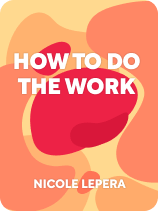

This article is an excerpt from the Shortform book guide to "How to Do the Work" by Nicole LePera. Shortform has the world's best summaries and analyses of books you should be reading.
Like this article? Sign up for a free trial here.
Looking for an overview of How to Do the Work, Dr. Nicole LePera’s bestselling book? What is LePera’s most important advice from the book?
According to LePera’s How to Do the Work, many people engage in self-sabotaging patterns that prevent them from being happy. Despite their efforts to change, they end up reverting to their unwanted behaviors and feel powerless to adopt healthier patterns.
Keep reading for a three-part overview of How to Do the Work by Dr. Nicole LePera.
Overview: How to Do the Work by Dr. Nicole LePera
According to Nicole LePera, bestselling author of How to Do the Work, self-sabotaging patterns create recurring problems that prevent people from feeling happy. These patterns can include irrational emotional reactions and damaging behaviors such as chronic worrying, outbursts fueled by insecurities or anger, and self-destructive habits—for example, procrastinating or overeating.
Since these sorts of patterns create undesirable symptoms, it’s important to overcome them and adopt more positive patterns. However, many people fail to make the changes they want. As a result, they feel like they must accept their patterns as an unchangeable part of who they are.
(Shortform note: Psychologists add insight into what self-sabotaging patterns are and why people might fail to overcome them. You’re self-sabotaging when you engage in behaviors that thwart your goals—for example, wanting to be in a committed relationship but cheating on your partner. Every failed attempt to move toward your goal makes you believe that you can’t or shouldn’t achieve your goal. And this belief reinforces your self-defeating behaviors. For example, cheating on your partner makes you feel guilty. Your guilt convinces you that you don’t deserve to be in a relationship. Even though you want a relationship, believing that you don’t deserve to be in one discourages you from changing your behavior.)
LePera argues that you can take control of patterns that don’t serve you and live a healthier, happier life. According to her, self-sabotaging patterns stem from unresolved childhood traumatic experiences. Therefore, the key to adopting more positive patterns lies in identifying and healing painful childhood experiences.
Part 1: Self-Sabotaging Patterns & Childhood Trauma
To begin, Dr. Nicole LePera’s How to Do the Work explains how your childhood experiences led you to subconsciously adopt self-sabotaging patterns. It also examines why it’s difficult to change unwanted patterns.
According to LePera, before you can overcome your self-sabotaging patterns, you first need to understand why you engage in them. This knowledge will empower you to take control of your unwanted behaviors.
(Shortform note: Like LePera, James Allen (As A Man Thinketh) argues that you must understand why you behave the way you do before you can change your behaviors. Without this understanding, you’re more likely to believe that you have no control over the way you act, and you won’t feel motivated to improve your behaviors.)
LePera argues that the reason it’s difficult to overcome self-sabotaging patterns is that you never consciously chose to engage in these patterns. Rather, you subconsciously adopted them as a way to cope with painful childhood experiences that made you feel unsafe or unloved.
Part 2: Childhood Patterns & Negative Effects
Next in How to Do the Work, Dr. Nicole LePera explores how automatically engaging in childhood patterns negatively affects your emotions, your relationships, and your mental and physical health. This knowledge will help clarify why it’s so important to become conscious of and replace the childhood patterns that don’t serve you.
According to LePera, automatically engaging in defensive childhood patterns creates three negative effects:
- You don’t know how to recognize and fulfill your needs.
- You unintentionally replicate childhood relationships.
- You suffer from elevated stress levels that damage your health.
Part 3: Replace Unwanted Childhood Patterns
The final section of Dr. Nicole LePera’s How to Do the Work focuses on replacing defensive childhood patterns with healthier ones.
LePera argues that the most effective way to overcome defensive childhood patterns is to consciously address the childhood experiences that caused you pain. According to her, the reason your defensive patterns hold so much sway over you is that you’re still using them to avoid feeling your childhood pain. And, because you didn’t consciously feel and process these painful emotions, they continue to live within your subconscious mind and influence all your behaviors.
Therefore, she suggests that you revisit the childhood beliefs and experiences that instigated your defensive patterns, acknowledge how they impact your current patterns, and create new beliefs that support healthier patterns.
(Shortform note: Tony Robbins (Awaken the Giant Within) expands on what LePera says here by claiming that the more you attempt to avoid painful emotions, the more likely you are to engage in behaviors that exacerbate your emotional pain. These behaviors include shunning situations that might trigger painful emotions—which means you miss out on experiencing positive emotions that these situations might elicit, and pretending not to feel your emotions—which means painful emotions become increasingly intense and eventually lead to irrational outbursts. Like LePera, he suggests that you can process your painful emotions and relieve your discomfort by acknowledging and accepting where these feelings came from.)

———End of Preview———
Like what you just read? Read the rest of the world's best book summary and analysis of Nicole LePera's "How to Do the Work" at Shortform.
Here's what you'll find in our full How to Do the Work summary:
- How childhood conditioning impacts your mental and physical health
- How to develop positive patterns that improve your well-being
- Tools to feel happier, healthier, and more in control of your life






